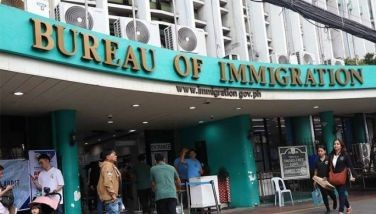EDITORIAL – Tribute to courage
April 9, 2003 | 12:00am
 Talk about war and people immediately think you’re referring to the one in Iraq. Every year there are fewer people left with first-hand memories of the last world war. Few people remember the courageous soldiers who defended Bataan in the final days before the start of the Japanese occupation, or the forced march to Tarlac that killed thousands of Filipino and American soldiers. This year, in the name of so-called holiday economics, the government has even moved the observation of Araw ng Kagitingan, the Day of Valor, two days early.
Talk about war and people immediately think you’re referring to the one in Iraq. Every year there are fewer people left with first-hand memories of the last world war. Few people remember the courageous soldiers who defended Bataan in the final days before the start of the Japanese occupation, or the forced march to Tarlac that killed thousands of Filipino and American soldiers. This year, in the name of so-called holiday economics, the government has even moved the observation of Araw ng Kagitingan, the Day of Valor, two days early.
The few men left who fought in Bataan can still be seen every year on this date, attending ceremonies in the shrines dedicated to the Fall of Bataan and the Death March. Ailing or debilitated by age, they may not inspire younger generations to show the same courage and selfless love of country. The veterans of Bataan — and even veterans of wars in Korea and Vietnam where the Philippines sent military teams — subsist on starvation pensions. And while they fought alongside American troops, Philippine veterans do not enjoy the same benefits as their US counterparts.
In 1941 the Japanese Imperial Army had planned to hit Hawaii and then the Philippines to neutralize US forces in the Pacific. Pearl Harbor was quickly destroyed. But in this country Filipino and American soldiers fought off the invaders, moving to Bataan shortly after Christmas 1941 and upsetting the Japanese war plans. For over four months the soldiers endured hunger, malaria and diarrhea as they repulsed the Japanese.
Bataan eventually fell, 61 years ago today. Up to 70,000 Filipinos and 11,000 Americans who surrendered were forced to march 120 kilometers to San Fernando, Pampanga without food or water. They were then packed into trains bound for Capas, Tarlac, then forced anew to march the last 13 kilometers to Camp O’Donnel. Only 54,000 survived the march. At the end of the war only 4,000 prisoners were left at the camp.
Only a handful of these brave soldiers survive to this day. If the government can’t take better care of them, the nation can at least pay tribute to their courage, and light candles for those who have passed away.
BrandSpace Articles
<
>
- Latest
- Trending
Trending
Latest
Recommended



























